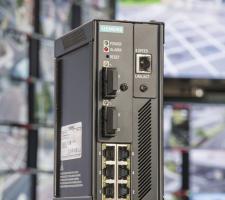
Like many US cities, Stamford had previously relied on an antiquated traffic system. A twisted-pair, copper-based serial communications network relied on 2400 baud Bell modems at traffic signals to provide an operations centre with minimal data at low speeds. This approach produced a murky, delayed view of traffic signal functionality and traffic flows. Field crews manually set traffic signals, returned to tweak settings and moved on to the next intersection.
The old system lacked remote access for monitoring and control and its low data speeds and bandwidth limited its functionality. As a result, city-wide traffic optimisation was more of an art than science. Stamford recognised that it needed to migrate from its legacy, serial data network to a future-facing internet protocol (IP)-based network that could deliver higher data speeds and bandwidth to support advanced sensors and video. The new network would enable remote monitoring and control of traffic signals, optimise traffic flows, identify problems in real time, and support future applications such as autonomous vehicles (AVs).
Meaningful transfer
“Transportation plays a big role in the local economy and quality of life because of our own needs in Stamford, our inter-city and inter-state needs, and our proximity to New York City,” said Veera Karukonda, signal systems engineer for the city of Stamford. “So we had to design and build a new IP-based network to achieve any meaningful transfer of data for a reliable, forward-looking ITS.”
City staff had previously used traffic control and communications equipment that relied on cooling fans, which failed to perform 24/7 and were not reliable. The city started its search for a reliable fibre-optic switch for its new fibre optic communications system.
“In my 30 years’ experience in traffic control, I’ve learned that if the fans on a switch go out, the equipment will fail and we lose control of the system,” he says. “For a city-wide new communications infrastructure project, that scenario is a non-starter.”
According to Karukonda, Siemens provided “positive interactions with the right people at the right time…We needed one simple platform to establish a new system without any guesswork. And we really needed ongoing support from the ‘day after’ [the network went live]”.
Multiple intersections
Several factors influenced the subsequent design of a city-wide, 10-gigabit fibre network backbone, as well as hubs to handle multiple intersections in different parts of the city.
First, the backbone would have to serve current needs with an assumption that population, traffic, and complexity would grow in coming decades. Second, the increasing role of video detection and surveillance in ITS and higher resolution cameras required significant network capacity, with significant ‘headroom’ for future growth. Third, the network would need extra capacity to support both nascent and unforeseen applications.
“With the cost of sensors and video cameras dropping, and with the evolution of video camera capabilities requiring more bandwidth, and increasing year-over-year, we needed to build
a network with lots of headroom,” Karukonda said. “The 10 gigabit of bandwidth that we currently have with the Siemens-designed network backbone will be sufficient for a very long time to come.”
Stamford’s resulting ITS network relies on two integrated switch and router multi-service platforms with high port density at each hub to provide redundant support to managed Ethernet switches for traffic signal monitoring and control, and to support its nine port-managed gigabit Ethernet switches that handle each intersection’s video feeds.
Stamford’s concern for reliability was laid to rest. All Ruggedcom platforms, routers and switches are designed for harsh field conditions that include extreme temperatures, vibration, dust, and electro-magnetic interference (EMI). Ruggedcom components meet NEMA TS-2 standards for traffic control equipment, deliver error-free performance in high EMI environments, and are built to operate reliably from -40 degrees C to 85 degrees C. That guarantees functionality over Stamford’s long hot summers, and the city’s unpredictable winters.
The multi-service platforms – the workhorses in this network topology – provide integrated router/firewall/virtual private network and other cybersecurity functions and measures. A network management system (NMS) allows operators to see and manage the functionality of every node on the network.
Bird’s eye view
Stamford moved from a low-visibility, manually-operated traffic signal network to a secure, efficient, state-of-the-art network with remote monitoring and control. This enables secure remote access for monitoring and control by Stamford’s traffic signal engineers at the city’s operations centre, which created a sea change in operational efficiencies. “The NMS provides a tool to understand all that is happening,” Karukonda says. “With hundreds of intersections and controllers in our system, we need a screen that shows the system’s status, the status of each sensor, camera and controller. The NMS provides us with that information. It gives us a birds-eye view of our whole city on one screen.”
For a traffic control engineer, remote access provides a real advantage, Karukonda adds. “We can make instant modifications and change settings, from our operations centre or while we’re in the field, on the fly.”
Since embarking upon its future-facing ITS, the city of Stamford has methodically extended functionality across the city in phases, with an eye on the future. “Since our experience has been positive, beginning with baby steps, we gained confidence in our chosen solution and the project proceeded,” Karukonda says.
Stamford is already sharing traffic data with its citizens so they can determine the most efficient commuting routes, avoid unforeseen delays, and improve their quality of life. City officials were quick to grasp the value of data-driven solutions for future needs. “To illustrate the value of the new network, our city has approved the funding for a full-time position for ‘traffic data analyst’,” Karukonda explains. “Now we are in a position to analyse all that data and make the best use of it.”
After years of work, Stamford’s future is looking bright. “Exciting times are here,” Karukonda enthuses. “Connecticut’s governor has announced that it will be a leading state for testing AVs and the City of Stamford has been chosen as one of the first cities to test them. In order for AVs to navigate the city safely and efficiently, our traffic equipment must have the necessary radios and signal transmission capabilities running on dependable communications infrastructure and equipment. Our ITS provides a platform upon which we can build to aid the navigation of AVs. Our primary goal is the safety of our citizens. The end result will be amazing.”













